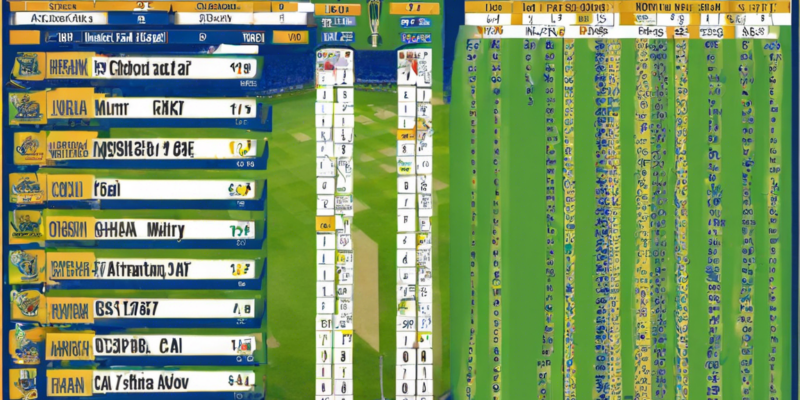The Odisha vs. Mumbai cricket match is a highly anticipated event that garners a lot of attention from fans across the country. As the two teams face off on the field, spectators eagerly keep track of the scorecard to stay updated on the latest developments in the game.
Importance of Scorecards in Cricket
Scorecards play a crucial role in cricket as they provide a detailed summary of the match, including the performance of individual players, team totals, and key milestones reached during the game. They serve as a valuable resource for fans, players, coaches, and analysts to assess the performance of each team and player. By analyzing the scorecard, one can gain insights into the strengths and weaknesses of the teams, identify standout performers, and track the progress of the game.
Understanding the Scorecard
A typical cricket scorecard consists of various sections that capture different aspects of the game. Here are some key components commonly found in a cricket scorecard:
1. Team Information:
- Names of the two teams competing.
- Date, time, and location of the match.
2. Batting Team Performance:
- List of batsmen in the batting order.
- Runs scored by each batsman.
- Number of balls faced by each batsman.
- Number of boundaries and sixes hit.
- Details of how each batsman got out (dismissal).
3. Bowling Team Performance:
- List of bowlers used by the fielding team.
- Number of overs bowled by each bowler.
- Runs conceded by each bowler.
- Number of wickets taken by each bowler.
- Extras conceded by the bowling team.
4. Total Score:
- Total runs scored by the batting team.
- Total wickets lost by the batting team.
5. Extras:
- Details of extras like wides, no-balls, and byes conceded by the fielding team.
6. Fall of Wickets:
- Order in which batsmen got out.
- Runs scored when each wicket fell.
Key Highlights of the Odisha vs. Mumbai Cricket Match
The Odisha vs. Mumbai cricket match witnessed some thrilling moments and outstanding performances from players on both sides. Here are some key highlights from the match:
- Player of the Match: Mention the standout player who made a significant contribution to the match.
- Top Scorer: Identify the batsman who scored the most runs in the match.
- Best Bowler: Highlight the bowler who took the most wickets and bowled exceptionally well.
- Impactful Moments: Describe any game-changing moments or partnerships that influenced the outcome of the match.
Frequently Asked Questions (FAQs) About Cricket Scorecards
Here are some common questions that fans often have about cricket scorecards, along with brief and informative answers:
1. What is the purpose of a cricket scorecard?
– A cricket scorecard provides a detailed summary of a cricket match, including individual player performances, team totals, and key statistics.
2. How is a batsman’s performance shown on a scorecard?
– A batsman’s performance is typically depicted in terms of runs scored, balls faced, number of boundaries/sixes hit, and details of their dismissal.
3. What does the bowling section of a scorecard display?
– The bowling section lists the bowlers used, their overs bowled, runs conceded, wickets taken, and extras given away.
4. How is the total score calculated in cricket?
– The total score in cricket is the cumulative runs scored by the batting team, including extras, minus any wickets lost.
5. What is the significance of the fall of wickets in a scorecard?
– The fall of wickets indicates the order in which batsmen got out, along with the runs scored when each wicket fell, providing insights into the batting team’s performance.
6. Can you explain the extras section on a scorecard?
– The extras section lists additional runs conceded by the fielding team, such as wides, no-balls, and byes, which contribute to the batting team’s total score.
7. How do analysts utilize scorecards in cricket?
– Analysts use scorecards to assess player and team performances, identify trends, evaluate strategies, and gain insights for strategic decision-making.
8. Is there a standard format for cricket scorecards?
– While there are common elements in scorecards, the format may vary slightly based on the competition, level of the match, and the platform displaying the scorecard.
9. Why are scorecards important for fans and enthusiasts?
– Scorecards allow fans to track the progress of a match, understand key moments, celebrate player achievements, and engage with the game at a deeper level.
10. How can one access live scorecards during a cricket match?
– Live scorecards are available on various platforms, including websites, mobile apps, and television broadcasts, providing real-time updates on the ongoing match.
Conclusion
In conclusion, cricket scorecards are valuable tools that offer a comprehensive overview of a match’s proceedings, enabling fans and stakeholders to delve into the intricacies of the game. By understanding the components of a scorecard and keeping track of key highlights, enthusiasts can enhance their cricket-watching experience and appreciate the nuances of the sport even more. Whether it’s a high-stakes encounter like the Odisha vs. Mumbai match or a casual game, the scorecard remains a fundamental aspect of cricket that enriches the overall viewing experience.


